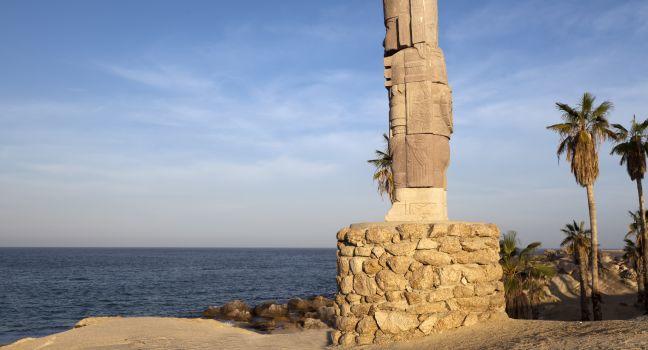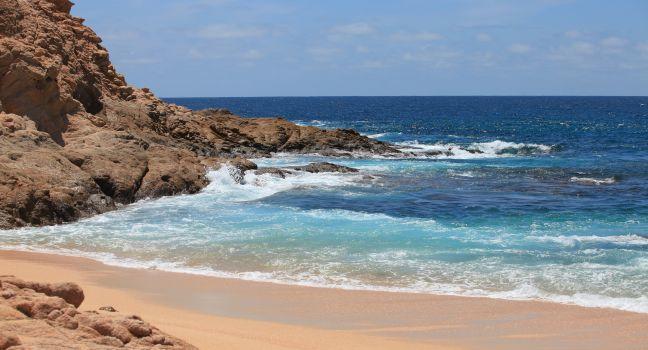One of the most dramatically beautiful ancient Maya cities, Chichén Itzá (pronounced chee-CHEN eet-ZAH) draws over one million visitors annually. Since the remains of this once-thriving kingdom were rediscovered by Europeans in the mid-1800s, many of the travelers making the pilgrimage here have been archaeologists and scholars who study the structures and glyphs and try to piece together the mysteries surrounding them. While the artifacts here give fascinating insight into Maya civilization, they also raise many unanswered questions.
The name of this ancient city, which means "the mouth of the well of the Itzá," is a mystery in and of itself. Although it likely refers to the valuable water sources at the site (there are several cenotes here), experts have little information about who might have actually founded the city; some structures, likely built in the 5th century, predate the arrival of the Itzá, who occupied the city starting around the late 8th and early 9th centuries. Why the Itzá abandoned the city in the early 1200s is also unknown, as is its subsequent role.
Most visitors who converge on Chichén Itzá come to marvel at its beauty. Even among laypeople, this ancient metropolis, which encompasses 6 square km (2¼ square miles), is known around the world as one of the most stunning and well-preserved Maya sites in existence.
You’ve likely seen photos of the immense pyramid, El Castillo ("Kukulkán" in Maya), but they can’t capture the moment you first gaze in person upon the structure rising imposingly yet gracefully from the surrounding plain. El Castillo (the Castle) dominates the site both in size and in the symmetry of its perfect proportions. Open-jawed serpent statues adorn the corners of each of the pyramid's four stairways, honoring the legendary priest-king Kukulcán (also known as Quetzalcóatl), an incarnation of the feathered serpent god. More serpents appear at the top of the building as sculpted columns. At the spring and fall equinoxes, the afternoon light strikes the trapezoidal structure so that the shadow of the snake god appears to undulate down the side of the pyramid to bless the fertile earth. Thousands of people, from international sightseers to Maya shamans, travel to the site each year to witness this phenomenon. Make lodging reservations far in advance if you hope to join them.
The question on everybody’s lips is: "May I climb the pyramid?" The answer is a resounding "No." Disappointing though that response may be, wear and tear on the staircases and numerous injuries to visitors have necessitated an end to the climbing.
Archaeologists are still abuzz about the 2015 discovery of a subterranean river flowing underneath the pyramid, detected via “electrical resistance survey.” While the Maya would likely have intentionally constructed El Castillo over such a river cavern, will the eventual effect be that of a gigantic sinkhole that could threaten the structure’s foundation? Time will tell, although experts suggest probably not yet for several generations.
The interior of El Castillo houses a marvelous statue of the intermediate god Chacmool. This part of the pyramid is no longer accessible to visitors, but four other Chacmool figures are scattered around Chichén Itzá. The most visible of them stands—or rather, reclines—at the Templo de los Guerreros (Temple of the Warriors), just northeast of the pyramid. A Chacmool always leans back, leaving a flat spot on the belly for receiving offerings.
On the Anexo del Templo de los Jaguares (Annex to the Temple of the Jaguars), just west of El Castillo, bas-relief carvings represent more important deities. On the bottom of the columns is the rain god Tlaloc. It's no surprise that his tears represent rain—but why is the Toltec god Tlaloc honored here, instead of the Maya rain god, Chaac?
That's one of many questions that archaeologists and epigraphers have been trying to answer, ever since John Lloyd Stephens and Frederick Catherwood, the first English-speaking explorers to rediscover the site, hacked their way through the surrounding forest in 1840. Scholars once thought that the symbols of foreign gods and differing architectural styles at Chichén Itzá proved it was conquered by the Toltecs of central Mexico. (As well as representations of Tlaloc, the site also has a tzompantli—a stone platform decorated with row upon row of sculpted human skulls—which is a distinctively Toltec-style structure.) Most experts now agree, however, that Chichén Itzá was only influenced—never conquered—by Toltec trading partners from the north.
Just west of the jaguar annex, another puzzle presents itself: the auditory marvel of Chichén Itzá's main ball court. At 490 feet, this Juego de Pelota is the largest in Mesoamerica. Yet if you stand at one end of the playing field and whisper something to a friend at the other end, incredibly, you'll be heard. The game played on this ball court was apparently something like soccer (no hands were used), but it likely had some sort of ritualistic significance. Carvings on the low walls surrounding the field show a decapitation, with blood spurting from the victim's neck to fertilize the earth. Whether this is a historical depiction—perhaps the losers or winners of the game were sacrificed?—or a symbolic scene, we can only guess. (Back in Mérida, the city tourist office stages a popular demonstration of the ball game each Friday evening in front of the cathedral. No one is beheaded.)
On the other side of El Castillo, just before a small temple dedicated to the planet Venus, a ruined sacbé, or raised white road, leads to the Cenote Sagrado (Holy Well, or Sinkhole), also probably used for ritualistic purposes. Jacques Cousteau and his companions recovered about 80 skeletons from this deep, straight-sided subsurface pond, as well as thousands of pieces of jewelry and figures of jade, obsidian, wood, bone, and turquoise. In direct alignment with Cenote Sagrado, on the other side of El Castillo, the Cenote Xtaloc was kept pristine, undoubtedly for bathing and drinking. Adjacent to this water source is a steam bath, its interior lined with benches along the wall like those you'd see in any steam room today. Outside, a tiny pool was used for cooling down during the ritual.
Older Maya structures at Chichén Itzá lie south and west of Cenote Xtaloc. Archaeologists have been restoring several buildings in this area, including the Templo del Osario (Ossuary Temple), which, as its name implies, concealed several tombs with skeletons and offerings. Behind the smaller Casa Roja (Red House) and Casa del Venado (House of the Deer) are the site's oldest structures, including El Caracol (the Snail), one of the few round buildings built by the Maya, with a spiral staircase within. Clearly built as a celestial observatory, it has eight tiny windows precisely aligned with the points of the compass rose. Scholars now know that Maya priests studied the planets and the stars; in fact, they were able to accurately predict the orbits of Venus and the moon, and the appearance of comets and eclipses. To modern astronomers, this is nothing short of amazing.
The Maya of Chichén Itzá were not just scholars, however. They were skilled artisans and architects as well. South of El Caracol, the Grupo de las Monjas (Nunnery Complex) has some of the site's most exquisite facades. A combination of Puuc and Chenes styles dominates here, with playful latticework, masks, and gargoylelike serpents. On the east side of the Anexo de las Monjas (Nunnery Annex), the Chenes facade celebrates the rain god, Chaac. In typical style, the doorway represents an entrance into the underworld, and figures of Chaac decorate the ornate facade above.
South of the Nunnery Complex is an area where field archaeologists are still excavating (fewer than a quarter of the structures at Chichén Itzá have been fully restored). If you have more than a superficial interest in the site—and can convince the authorities ahead of time of your importance, or at least your interest in archaeology—you can explore this area, which is generally not open to the public. Otherwise, head back toward El Castillo past the ruins of a housing compound called Akab Dzib and the Templo de los Panales Cuadrados (Temple of the Square Panels). The latter shows more evidence of Toltec influence: instead of weight-bearing Maya arches, or "false arches," that traditionally supported stone roofs, this structure has stone columns but no roof. This means that the building was once roofed, Toltec-style, with biodegradable materials (most likely palm thatch or wood) that have long since disintegrated.
Beyond El Caracol, Casa Roja, and El Osario, the right-hand path follows an ancient sacbé, now collapsed. A mud-and-straw hut, which the Maya called a na, has been reproduced here to show the simple implements used before and after the Spanish conquest. On one side of the room are a typical pre-Hispanic table, seat, fire pit, and reed baskets; on the other are the Christian cross and colonial-style table of the postconquest Maya.
Behind the tiny oval house, several unexcavated mounds still guard their secrets. The path meanders through a small grove of oak and slender bean trees to the building known today as El Mercado. This market was likely one end of a huge outdoor market whose counterpart structure, on the other side of the grove, is the Plaza de Mil Columnas (Plaza of the Thousand Columns). In typical Toltec-Maya style, the roof once covering the parallel rows of round stone columns in this long arcade has disappeared, giving the place a strangely Greek—and distinctly non-Maya—look. But the curvy-nosed Chaacs on the corners of the adjacent Templo de los Guerreros are pure Maya. Why their noses point down (like an upside down "U") instead of up is, as usual, just another mystery to be solved.
An evening sound-and-light show (8 pm Apr.--Oct., 7 pm Nov.--Mar.) is presented here, with images projected onto El Castillo pyramid—it's been described as everything from stunning to cheesy. Reservations must be booked in advance through the Noches de Kukulkán website (www.nochesdekukulkan.com). Area tour operators can also arrange tickets. The pricey admission includes a 30-minute guided walk followed by the light show, as well as use of a translation device (original narration is in Spanish only). Assorted problems occasionally plague the equipment; if the Maya gods are smiling, the show will be on during your visit. Inquire on-site, at area lodgings, or at the Yucatán tourist office in Mérida. Because of the lateness of the hour, it's easier to take in the evening show on your own if you're staying in the immediate area. Escorted tour groups do come in from as far away as Mérida or Cancún.





